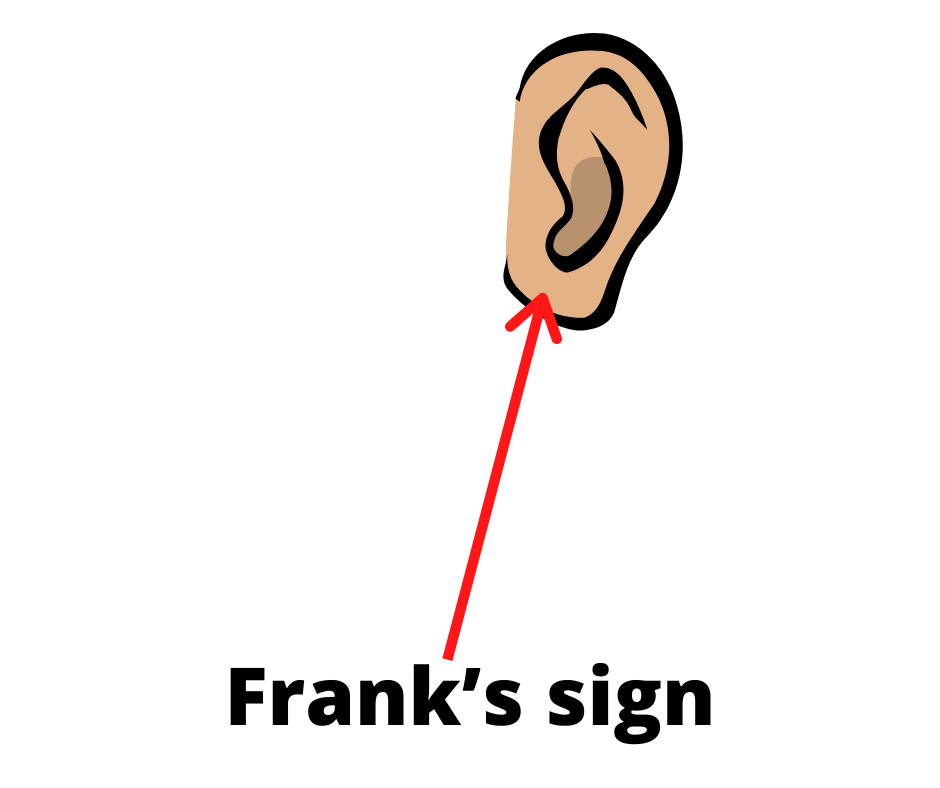Frank’s sign is a diagonal crease in the ear lobe which is considered as a predictive sign of heart disease. It was named after the American pulmonologist, Dr. Sanders T. Frank, who first noticed the connection between heart diseases and creases on one or both ear lobes. So, the crease is usually spread almost across the entire ear lobe, and in some cases, it looks as if it starts just from the hole through which the earring is placed.
The presence of Frank’s sign is associated with a decrease in telomere size, an accelerated aging marker, which may lead to atherosclerosis. It is thought to happen due to chronic local ischemia, leading to disruption and displacement of elastic fibers, associated with thickening of the intima of arterioles.
The first research
The first studies regarding Frank’s sign date back to 1973. the year in which Dr. S. Frank published a research article in which a possible correlation was hypothesized between the presence of this cutaneous marker and the development of cardiovascular diseases, especially coronary heart disease and diabetes. The article was published in the New England Journal of Medicine (NEJM) under the name “Aural sign of coronary-artery disease”. Many studies were conducted since then, showing a correlation between Frank’s sign and heart disease, exceptionally in people under the age of 60.
Frank’s sign classification
Classification of Frank’s sign was based on descriptive evaluation which includes:
- Grade 1 – a small amount of wrinkling on the earlobe
- Grade 2a – a superficial crease on the earlobe
- Grade 2b – a crease that surpasses more than halfway across the earlobe
- Grade 3 – a deep crease that affects the entire earlobe
Other indicators of heart diseases
Cardiovascular diseases are the leading cause of death, and commonly, the first sign of problems with heart may be a suffered heart attack, which is fatal in 30% of cases. Although it is impossible to detect all the warnings indicating that you have problems with your heart, there are some visible external signs that may predict a future cardiac event. Some of them include:
Nail clubbing
An occurrence recognized as nail clubbing can also represent a sign that there is something wrong with your heart. The nails are becoming thicker and wider, changing their shape. Such changes are often present in both hands, and they do not cause pain. The reason for nail clubbing is the insufficient supply of oxygenated blood to fingers, which they try to overcome with the increased production of growth factors.
Xanthomas
Large, yellow fatty bumps (Xanthomas) that can appear on your knees, elbows, or eyelids do not represent a danger on themselves, but their presence can indicate other problems. Moreover, these fatty bumps are generally seen in people with familial hypercholesterolemia, a genetic disorder that causes exceptionally high levels of low-density lipoprotein cholesterol (LDL-c) that are making fat deposits on the skin. In addition to that, fat deposits can accumulate in the arteries that supply the heart, causing various cardiovascular problems.
Arcus senilis
Arcus senilis represents fat deposits manifested via the white, grey or blue ring located around the cornea. It is caused by lipid deposits in the edge of the cornea. Although it doesn’t affect the vision, arcus senilis is correlated with heart diseases

